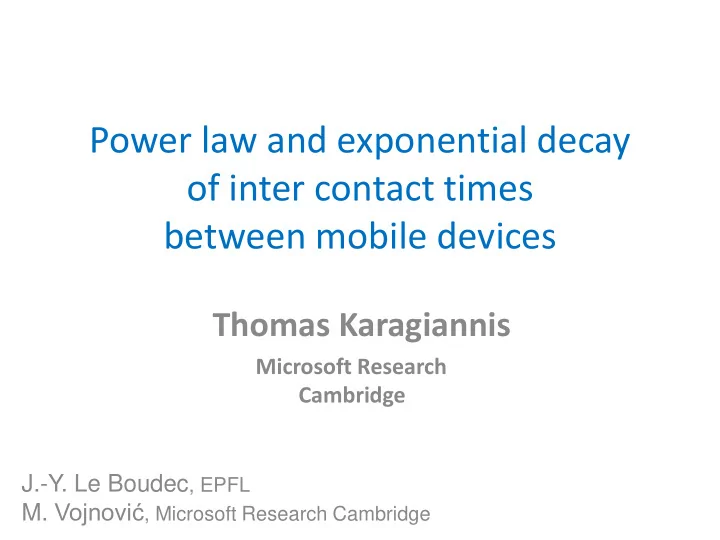

Power law and exponential decay of inter contact times between mobile devices Thomas Karagiannis Microsoft Research Cambridge J.-Y. Le Boudec , EPFL M. Vojnović , Microsoft Research Cambridge
Opportunistic communications 2
Power-law finding • Distribution of inter-contact time exhibit power-law over a large range! – Chaintreau et al. -- Infocom 06 • State of the art until 2006: – Distribution of inter-contact time between mobile devices decays exponentially 3
Power tail hypothesis • Hypothesis based on empirical finding – Power-law tail • Bad news for forwarding schemes! – For sufficiently heavy tail, expected packet delay is infinite for any packet forwarding scheme Assume a Pareto CCDF of inter-contact time : If a <= 1, expected packet forwarding t 0 ) 0 0 F ( t delay infinite for any forwarding scheme 0 , t t 0 t 4
Failure of mobility models • Empirical finding: 1/4 1/4 1/4 1/4 • Power-law decay • But: Mobility models feature exponential decay! 5
Contributions • Empirical evidence: We find a dichotomy in the inter- contact time distribution – Power-law up to a point (order half a day), exponential decay beyond – In sharp contrast to the power-law tail hypothesis • Analytical results – Dichotomy supported by (simple) mobility models – Exponential tail applicable to a broad class of models • Understanding the origins of the dichotomy – Can return time explain the inter-contact time dichotomy? – Is dichotomy an artifact of aggregation? 6
Outline • Power-law, exponential dichotomy • Mobility models support the dichotomy • Origins of the dichotomy • Conclusion 7
Datasets • All but the vehicular dataset are public and were used in earlier studies • Vehicular is a private trace (thanks to Eric Horvitz and John Krumm, Microsoft Research MSMLS project) 8
Power law 9
Power law (2) 10
Exponential decay 11
Outline • Power-law, exponential dichotomy • Mobility models support the dichotomy • Origins of the dichotomy • Conclusion 12
Inter-contact time is exponentially bounded RETURN TIME FOR FINITE MARKOV CHAIN K ( n ) [ a cos( n ) b sin( n )] k k k k f(n) ~ g(n) means f(n)/g(n) k 1 goes to 1 as n goes to infty 13B
What does this mean? • Inter-contact time is exponentially bounded: – if the mobility of two nodes is described by an irreducible Markov chain on a finite state space • General result for a broad class of models – No need for further assumptions – Enough that the chain is irreducible 14
Examples of applicable mobility models 1/4 1/4 1/4 1/4 15
Simple random walk on a circuit 0 1 2 4 3 0 1 m-1 2
Return time to a site 0 R = 8 1 8 2 4 3 5 6 0 7 1 m-1 2
Return time to a site of a circuit • Expected return time: R E ( ) m • Power-law for infinite circuit: 2 1 P ( R n ) ~ , large n 1 / 2 n • Exponentially decaying tail: n P ( R n ) ~ ( n ) e , large n , 0 18
Inter-contact time 0 T = 5 1 2 4 3 5 0 1 m-1 2
Inter-contact time on a circuit • Expected inter-contact time: m E ( T ) 1 • Power-law for infinite circuit: 2 1 P ( T n ) ~ , large n 1 / 2 n • Exponentially decaying tail: n P ( T n ) ~ ( n ) e , large n , 0 Qualitatively same as return time to a site 20
Inter-contact time on a circuit of 20 sites • Power-law, exponential dichotomy 21
Outline • Power-law, exponential dichotomy • Mobility models support the dichotomy • Origins of the dichotomy • Conclusion 22
Is inter-contact time distribution explained by return time? Power-law, exponential dichotomy Devices in contact at a few sites 23
Aggregate viewpoint • In most studies: Inter-contact time CCDF estimated – over a time interval – taking samples over all device pairs • Unbiased estimate if inter contacts for distinct device pairs statistically identical • But, behavior is not homogeneous across devices – Is power-law an artifact of aggregation? 24
Aggregate viewpoint • CCDF of all pair inter-contact times equivalent to: • Picking a time t uniformly at random • Picking a device pair p uniformly at random • Observe the inter-contact time for pair p from time t • Aggregate vs. device pair viewpoint: • In general not the same • Some variability across device-pairs • Dichotomy is also present for distinct device-pairs 25
Summary & Implications • Dichotomy in the distribution of inter-contact time – Power-law up to a characteristic time – Exponential decay beyond Infinite packet delay does not appear relevant • Mobility models – Simple models support the observed dichotomy – Exponential tail for a broad class of models Should not be abandoned as unrealistic • Origins of dichotomy – Return time might explain dichotomy inter-contact time – Heterogeneity does not appear to be the cause 26
First ACM SIGCOMM Workshop on Social Networks (WOSN 2008)
Recommend
More recommend